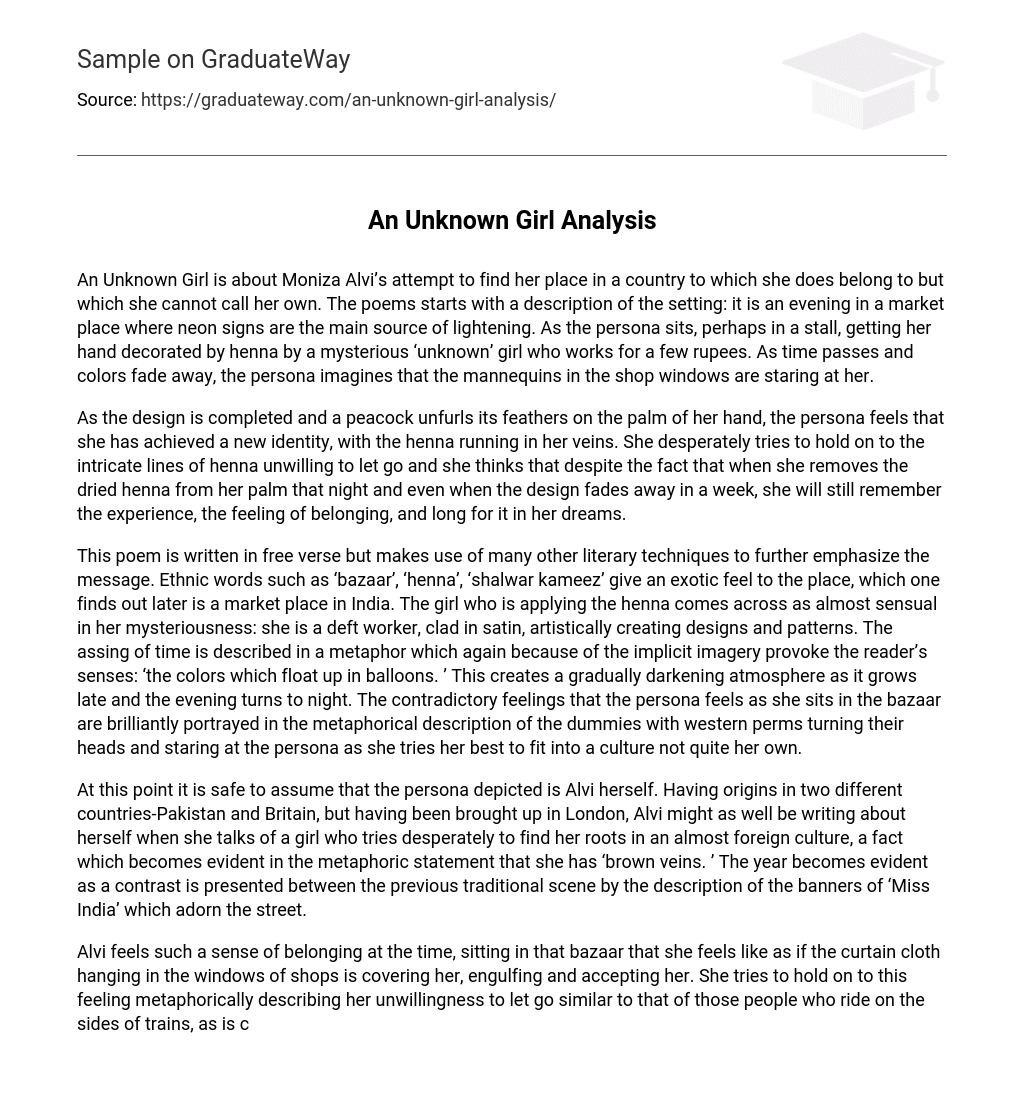An Unknown Girl is about Moniza Alvi’s attempt to find her place in a country to which she does belong to but which she cannot call her own. The poems starts with a description of the setting: it is an evening in a market place where neon signs are the main source of lightening. As the persona sits, perhaps in a stall, getting her hand decorated by henna by a mysterious ‘unknown’ girl who works for a few rupees. As time passes and colors fade away, the persona imagines that the mannequins in the shop windows are staring at her.
As the design is completed and a peacock unfurls its feathers on the palm of her hand, the persona feels that she has achieved a new identity, with the henna running in her veins. She desperately tries to hold on to the intricate lines of henna unwilling to let go and she thinks that despite the fact that when she removes the dried henna from her palm that night and even when the design fades away in a week, she will still remember the experience, the feeling of belonging, and long for it in her dreams.
This poem is written in free verse but makes use of many other literary techniques to further emphasize the message. Ethnic words such as ‘bazaar’, ‘henna’, ‘shalwar kameez’ give an exotic feel to the place, which one finds out later is a market place in India. The girl who is applying the henna comes across as almost sensual in her mysteriousness: she is a deft worker, clad in satin, artistically creating designs and patterns. The assing of time is described in a metaphor which again because of the implicit imagery provoke the reader’s senses: ‘the colors which float up in balloons. ’ This creates a gradually darkening atmosphere as it grows late and the evening turns to night. The contradictory feelings that the persona feels as she sits in the bazaar are brilliantly portrayed in the metaphorical description of the dummies with western perms turning their heads and staring at the persona as she tries her best to fit into a culture not quite her own.
At this point it is safe to assume that the persona depicted is Alvi herself. Having origins in two different countries-Pakistan and Britain, but having been brought up in London, Alvi might as well be writing about herself when she talks of a girl who tries desperately to find her roots in an almost foreign culture, a fact which becomes evident in the metaphoric statement that she has ‘brown veins. ’ The year becomes evident as a contrast is presented between the previous traditional scene by the description of the banners of ‘Miss India’ which adorn the street.
Alvi feels such a sense of belonging at the time, sitting in that bazaar that she feels like as if the curtain cloth hanging in the windows of shops is covering her, engulfing and accepting her. She tries to hold on to this feeling metaphorically describing her unwillingness to let go similar to that of those people who ride on the sides of trains, as is common for villagers to do in India and Pakistan. Again the passage of time is described by the fading of noise, proving the auditory sense of the reader.
The previous hum of activity described recedes as the bazaar becomes quiet and the future tense is used to show Alvi’s thoughts as she muses on how despite the fact that the color on her hand will fade away, she shall always remember the time she felt that she really belonged to her country, and will yearn for the reoccurrence of the feeling in her dreams. After analyzing the poem at great depth it becomes apparent that the title is not only for the girl who is applying the henna, who remains unnamed and therefore unknown throughout.
Rather it can also define the persona, and thus Moniza Alvi herself, as she is a stranger amidst her own people on account of having lived her whole life elsewhere. The dilemma which she is faced with is in today’s world a common phenomenon with bi-cultural marriages becoming more and more common. What Alvi feels, the sense of detachment from either of the two countries she belongs to is something that most of us can relate to as we are the generation which was born to parents who immigrated to other countries and therefore have lived all our lives in a foreign home.
Such people do not feel that they wholly belong anywhere. The place where they have lived all their lives and that which they call home isn’t really enough as they would always have a different set of origins calling out to them; and the quest to find one’s roots and culture leaves one not only dissatisfied, but also all the more desolate and alone. Neither country will whole heartedly accept them, nor can they accept only one country. They are torn between two worlds, two different realities, each of which constitutes half of their identity.
Thus their sense of self is shaken, and even lost as their identities are torn apart, distanced by oceans and deserts.





